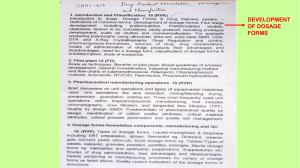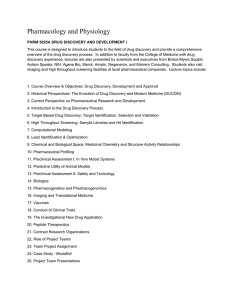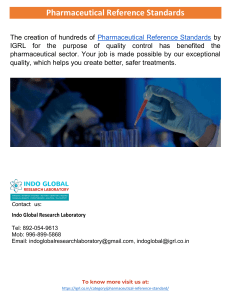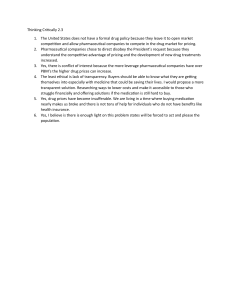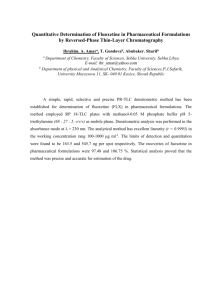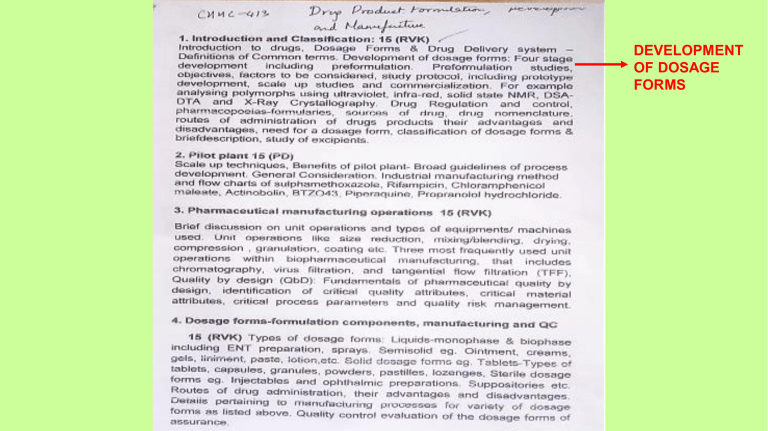
DEVELOPMENT OF DOSAGE FORMS Four Stages of Pharmaceutical Product Development: Preformulation, Prototype Development and Scale-Up, Biological Aspects, and Commercialization The PREFORMULATION STUDIES refer to the studies done at the early stages of the development process of drug candidates into different dosage forms. Investigation of both the physical and chemical properties of these candidates are achieved during the preformulation stage in order to identify the critical features that affect the selection of the most appropriate candidate . Preformulation studies have been reported to act as accurate predictors that effectively predict the changes that may be associated with the combination process of the active pharmaceutical ingredient (API) with a suitable delivery system that is intended to safely and effectively deliver the active ingredient to the patient. Preformulation studies are usually Pure Drug free from classified into three main phases, residual impurities Three phases of preformulation studies. as… Preformulation studies have been shown to play an important role during processes of drug discovery and development since these studies are usually relied on when valuable information is needed regarding stages of lead identification and optimization. The role of the data collected during the preformulation studies varies based on the different groups involved in the discovery and development stages. Different groups in a drug’s discovery and development stages. PROTOTYPE DEVELOPMENT : The prototype development is an important stage during the development of a new product that represents the primary working model of the product which will then be perfected in the form of the final product. Basically, there are four phases of prototype development. BIOLOGICAL ASPECTS IN PHARMACEUTICAL PRODUCT DEVELOPMENTThe Preclinical Tenure and Strategies: Three essential parts are involved in the preclinical stage of drug development. The first part focuses on the in vitro models and their importance in the preclinical stage, whereas the second part provides a brief discussion about the application of new in silico models and how simulation prediction has aided in the efficiency of the drug development process, and the last part covers the issue of using animals as models for testing some properties of the newly-synthesized drugs. The use of in vitro models usually provides information in the early stage of preclinical development regarding probable biological performance of the drug product. It is proven that data obtained by these models provide very useful information to be further used for in vivo testing. In vitro methods have to be validated. This will aid in the characterization of the drug formulation more properly before the drug is given to humans. In Silico Models and Simulation Predictions- Computational prediction models are shown to have an observable role in modern medicinal chemistry since these models offer a high potential to transform the drugs’ early research phases, in terms of saving both time and cost. In silico methods of prediction and assessment are of a noticeable importance because the lack of such models would make it very difficult and even impossible to assume all factors affecting the prediction by in vitro/in vivo models. Researchers are shifting from applying principles of random screening into methods that are more rational. This has shown to have a direct effect on the rate of success of a new chemical entity (NCE) development and, hence, improve the productivity of the pharmaceutical research and development. Nowadays, virtual screening models are considered as essential components in the modern process of drug discovery. . Computational tools are also playing a critical role in medicinal chemistry programs. Similarly, various computational tools are available to predict API’s solubility/miscibility/or possible reaction with single or mixture of raw materials. With time such tools will become necessary to develop a drug product to save resources, like time and money. The Use of Animal Models It is known that testing pharmaceutical formulations directly in humans is an unaffordable and unethical process. Thus, the establishment of in vivo in vitro correlation (IVIVC) is essential for the prediction of the performance of such formulations in humans, which may, therefore, minimize the risk of failure in the firstin-human (FIH) studies. Animal models that are commonly used in the pharmaceutical field include rats, guineapigs, dogs, and monkeys. These animal models are used for the evaluation of the performance of the newly-formulated drug product before testing in humans. Many new pharmacokinetic software designed on physiologic bases, such as GastroPlus and PK-SIM, are being applied for testing the behavior of new formulations. The quality of such software is dependent on how precise the input data is. However, the awareness regarding the inability of animal models to reliably predict formulations’ behavior in clinical trials is increasing. Despite the wide use of mice, they are still considered as poor models for most human diseases. COMMERCIALIZATION ASPECTS IN PHARMACEUTICAL PRODUCTS DEVELOPMENTPatents, Exclusivity, and Evergreening Strategies…Must Commercial success of pharmaceutical companies is widely dependent on the activities during the stages of research and development. These activities usually provide information regarding the efficacy, safety, as well as the tolerability of drugs to the regulatory agencies. CONCLUSION- There are a number of emerging trends in the field of pharmaceutical industry development, such as the Pharmacovigilance, pharmacogenomics, drug repositioning, and the use of cell lines and cultures of human origins. Drug commercialization and the challenges facing the pharmaceutical companies are now focused on the field of pharmaceutical research and development. Drug repositioning - the use of a drug in an indication other than the one for which it was initially marketed, is a growing trend.
